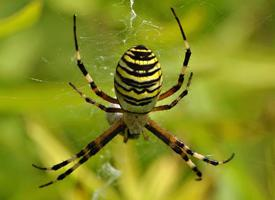
Poids et mesures
| Longueur | de 5 à 17 mm |
|---|
Données biologiques
| Durée de vie | 3 r |
|---|
Description de l'animal
The European garden spider, scientifically known as Araneus diadematus, is a fascinating creature that has captured the attention of both arachnologists and nature enthusiasts alike. This species is particularly noted for its distinctive markings and its role in the ecosystem. Originating from Europe, it has since spread to other parts of the world, including North America, where it is commonly found in gardens, forests, and meadows.One of the most striking features of the European garden spider is its size and coloration. Adult females can grow to a body length of up to 15mm, with males being slightly smaller, typically reaching about 10mm. The color palette of these spiders can vary but often includes shades of brown, gray, and yellow, which provide excellent camouflage against the bark of trees and the stems of plants. The most notable characteristic, however, is the pattern on the abdomen. A series of white spots often forms a cross-like shape, which has led to the nickname "cross spider" in some regions. This distinctive pattern is not just for show; it plays a crucial role in deterring predators by breaking up the spider's outline and making it harder to spot.
The web of the European garden spider is a masterpiece of natural engineering. These spiders construct orb webs, which are circular and can be quite large, sometimes reaching up to 40cm in diameter. The web is usually positioned between plants or across paths where insects frequently fly. The spider spends much of its time in the center of the web, waiting patiently for prey to become ensnared. Once an insect is caught, the spider quickly immobilizes it with a bite and then wraps it in silk, saving it for a later meal.
European garden spiders have a fascinating life cycle. They are most visible from late summer to fall, which is their breeding season. After mating, the female lays eggs in a silk sac, which she attaches to a sheltered location. The eggs overwinter, and the spiderlings emerge in the spring. These young spiders are highly independent and disperse shortly after hatching, often using a technique known as ballooning, where they release a thread of silk to catch the wind and carry them to a new location.
In terms of behavior, the European garden spider is generally non-aggressive towards humans and will only bite if directly threatened. The bite is not considered dangerous and typically results in nothing more than mild, temporary discomfort.
The European garden spider plays a vital role in controlling insect populations, making it a welcome guest in many gardens. By preying on common pests, these spiders contribute to the health of plants and reduce the need for chemical pesticides. Their presence also supports biodiversity by providing food for other wildlife, including birds and small mammals.
In conclusion, the European garden spider is a remarkable creature that combines beauty, fascinating behavior, and ecological importance. Its presence in the garden is not only a sign of a healthy ecosystem but also provides an opportunity for observation and appreciation of the intricate connections within nature.
Animaux similaires
Nouvelles photos d'animaux
Top 10 des animaux
- Dolphin gull (Leucophaeus scoresbii)
- Japanese macaque (Macaca fuscata)
- Stone loach (Barbatula barbatula)
- Greek tortoise (Testudo graeca)
- Russian tortoise (Testudo horsfieldii)
- Galápagos tortoise (Geochelone nigra complex)
- Diana monkey (Cercopithecus diana)
- Moustached guenon (Cercopithecus cephus)
- Common flying dragon (Draco volans)
- Galápagos penguin (Spheniscus mendiculus)
